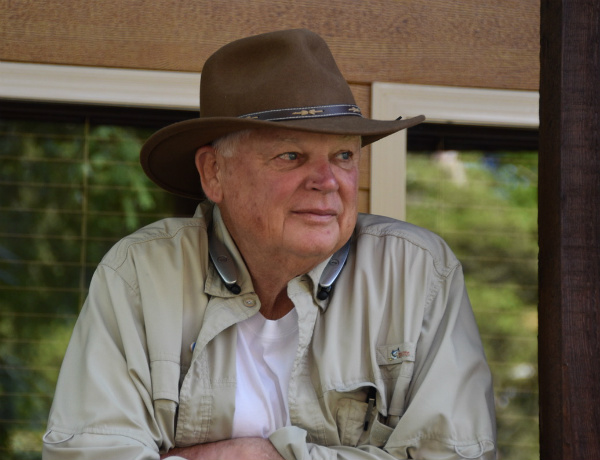37-Year Mesothelioma Survivor Grateful for Alternative Therapy

Jerry Lampe often does his morning prayer in front of the bathroom mirror, lifted by the visual reassurance — and continued surprise — that he is alive and well.
Then another great day begins.
Lampe, 75, might be the country’s longest-living mesothelioma survivor, a beacon of hope who defied the odds of those diagnosed with the debilitating cancer.
Miracles do happen.
“I say my prayer of thanks for the privilege of another day,” Lampe told Asbestos.com. “It’s my way of not forgetting reality, but I often ask myself why [I am still alive]?”
Lampe, who lives near Kansas City, was diagnosed 37 years ago with peritoneal mesothelioma, discovered during a bowel obstruction surgery that turned into a six-hour cytoreduction to eliminate all visible signs of cancerous tumor cells.
Treatments Limited in 1980
The discovery was shocking, prompting post-operative consultations at M.D. Anderson Cancer Center in Houston, Memorial Sloan Kettering Cancer Center in New York and Roswell Park Cancer Institute in Buffalo, New York, where he heard a similar refrain each time.
They all told him, in different ways, the mesothelioma tumor cells likely would return with a vengeance, giving him a tough life expectancy of six to 12 months.
This was 1980, well before peritoneal mesothelioma therapy had advanced where it is today. He was offered systemic chemotherapy, which he rejected after considering the short-term debilitating side effects and the lack of long-term effectiveness.
“I studied it, and found that patients who received treatment had a much rougher time, sooner than those who didn’t take treatment,” he said. “So I went home, figuring I’d just spend time with my wife and two children.”
The kids were 11 and 5 at the time.
Immunotherapy Treatment in the Bahamas
Lampe, who worked in the health care industry, had a friend who suggested the Immune Augmentation Therapy (IAT) Clinic in Freeport, Bahamas.
The controversial cancer-care clinic opened just three years before, treating cancers with the philosophy of restoring, revitalizing and fine-tuning a patient’s own immune system to fight off the tumor growth.
There was no radiation, surgery or chemotherapy there, only daily injections of a protein mixture made from the blood of healthy donors, individualized to augment a patient’s own immune system.
It was run by founder Dr. Lawrence Burton and medical director Dr. John Clement.
“I remember we asked [Burton] if he thought he could help me, and he said ‘I don’t know. We’ve never treated [mesothelioma] before,’” Lampe said. “For me, it was worth the try.”
Lampe stayed for five weeks of treatment initially, getting four to 10 injections daily. He typically would stay at the clinic for seven days, return home, and go back every eight to 10 weeks for more immune system adjustment.
He followed the routine from 1980 to 1984.
IAT Operated Outside of US Regulation
Although the theory behind the treatment was a precursor to today’s more accepted immunotherapy, IAT worked outside any regulation or oversight from the U.S. medical community.
Established oncologists often scoffed at mention of the clinic, and there was no scientific evidence proving it worked. Patients such as Lampe, though, believed it saved their lives, even while the U.S. Food and Drug Administration lobbied to close it.
Lampe helped Clement author a report in a British medical journal, detailing an improved survival rate for cancer patients who underwent treatment at the Freeport clinic.
“I don’t have any better explanation [why I’m alive today], other than divine intervention,” Lampe said. “I didn’t need proof beyond the fact I’m here today.”
Lampe left the clinic in 1985 and never returned. And neither did the mesothelioma tumors.
“It would be hard for me to give advice or recommendation to anyone else because so much has changed,” he said. “There is no way to prove now what it did or didn’t do for me back then.”
A changing philosophy, poor management and continued skepticism within the medical community essentially drove IAT out of business earlier this year.
Living an Active Lifestyle
Lampe starts each day with a prayer and an optimistic outlook. He retired a year ago from the physical therapy business.
He lives in rural Missouri on an 80-acre farm, much of which he rents to tenant farmers. Lampe often drives the Kubota tractor around the property, cutting grass and making sure all is well.
Lampe also teaches a class at nearby University of Saint Mary, along with another physical therapist.
Although he believes strongly in the theory of immunotherapy and strengthening the immune system to fight disease, Lampe stops short of offering any assurances for other mesothelioma patients.
“[IAT] built up my immune system, and I survived,” he said. “It seems like a short, logical road to conclude reasonably that it worked then. But that’s ancient history.”